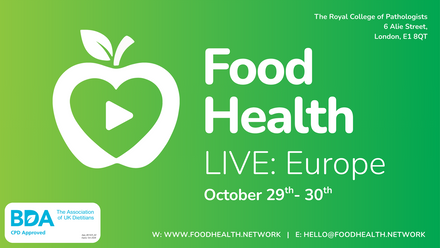Human and climate health are inextricably linked as areas of key societal concern when it comes to sustainability. The need to tackle these issues in parallel is evidenced in the UN’s Sustainable Development Goals, which aim by 2030 both to “reduce by one third premature mortality from non-communicable diseases…” (target 3.4) and “halve per capita food waste” (target 12.3).1,2
However, UK progress against these targets has been slow. Despite decades of public health nutrition policies in the UK, most of the population has suboptimal intake of fruits and vegetables, with only one in three adults eating their ‘5 A Day’.3
More concerning is that only one in ten adults is meeting the minimum recommended fibre intake of 30g of fibre per day.3 Higher dietary fibre intake is associated with lower risk of all-cause mortality, as well as cardiovascular disease and cancer mortality.4 As such, fibre remains a key nutrient of concern for the UK population.
Although promising progress was made against UK food waste reduction targets, with a decrease of 15% between 2007 and 2018,5,6 latest reports show that food waste increased between 2018 and 2021,7 and around 10 million tonnes of food waste are thrown away each year.8 Households and food service are the biggest contributors to food waste in the UK, wasting about 16% to 18% of food purchased.6
Edible food makes up around two-thirds of this waste, contributing to greenhouse gas emissions, and a significant proportion of this is from plant sources.9 In light of the cost-of-living crisis facing many UK households today, reducing edible food waste remains of economic as well as environmental importance.
It was considering these challenges that led researchers at King’s College London to ask the question: can we increase fibre intake AND reduce food waste in the UK population by eating more parts of the plants we harvest?
The ‘Root-to-Tip’ project is a collaboration between researchers across the Department of Nutritional Sciences, the Marketing Department at King’s Business School and King’s Food and the King’s in-house catering team. The project is funded by a One King’s Impact grant. The project is using a ‘Living Laboratory’ approach, where ‘Root-to-Tip’ recipes which use more parts of the plant have been developed, tested and launched to King’s staff and students across King’s Food venues since April 2025.
Twelve fruits and vegetables were selected to feature on the Root-to-Tip menu, with included components ranging from the more familiar, such as leek greens, to the exotic, such as watermelon rind.
Ahead of menu launch, the potential positive health and environmental impact of Root-to-Tip eating was explored. The dietary fibre content of the selected fruits and vegetables was analysed, comparing those parts commonly consumed, such as the flesh, with those which may be typically discarded, for example the skin, stalk or seeds.
Results showed that these ‘Root-to-Tip’ components were typically higher in fibre. Some differences were modest, with just 4% difference between kale stalks versus leaves, and others dramatic, with butternut squash seeds found to be almost 700% higher in fibre compared with the flesh. Broccoli was the only exception, with broccoli stalk found to be lower in fibre than broccoli florets.
When included as part of a meal on the Root-to-Tip menu, the fibre content of dishes was increased by up to around 15%.
So, what about waste saving? Analysis by King’s Food chefs showed that, when prepared to food service kitchen standards, between 25% and 48% of the edible part of the plant is thrown away.
When scaling this to the quantities consumed within a whole university, the potential implications for combating the climate impact of food waste become apparent.
As of the end of June, over 6,000 Root-to-Tip meals had been sold in King’s Food, preventing up to 245kg of food waste in just nine weeks, assuming no plate waste. Over a whole year, this equates to up to 1.4 tonnes of food waste potentially saved from landfill.
Although results from within food service look promising, Root-to-Tip eating will need to be adopted by everyday consumers in their homes to achieve long-lasting impact.
In the UK, household consumption of peels is currently low and reasons for this are poorly understood. Focus groups with King’s staff and students highlighted that communicating tangible personal benefits of cooking Root-to-Tip, such as for health and cost saving, would encourage behaviour change.
A supermarket benchmarking exercise demonstrated that using all edible parts of the plant could indeed save consumers money. On average, a saving of 18p per 100g could be made across the 12 types of produce included in the Root-to-Tip menu. For more expensive products, such as kale, savings are up to 34p per 100g.
Root-to-Tip cooking may be a method to support those at risk of or living with food insecurity, particularly when purchasing fresh produce, which can often be more expensive than pre-prepared convenience alternatives.
Supporting households by increasing cooking knowledge and skills may be important to help bring Root-to-Tip cooking into the home, to help people understand which parts of the plant are safe to eat, and how to prepare them in a way that is safe, efficient and enjoyable to eat.
To further investigate attitudes towards Root-to-Tip eating, a survey was conducted across King’s Food venues after menu launch.
Questions were designed to understand perceptions and purchase drivers of Root-to-Tip dishes compared with other menu offerings. Consumer awareness of the presence of Root-to-Tip components in their meal and of the project more generally were also tested, as well as an estimation of plate waste.
Survey and sales results from the nine-week evaluation period are currently undergoing analysis.
The ultimate ambition of the project is to disseminate Root-to-Tip principles across spheres of public health if a reduction in food waste in a way that improves fibre intake and is acceptable to consumers can be demonstrated.
Project findings will be first shared through The University Catering Organisation (TUCO), a professional membership body for in-house university caterers.
Further funding will then be sought to adapt the Root-to-Tip approach within public sector or contract catering, in the home and in retail, with the aim of helping to meaningfully increase UK population health and reduce plant-food waste in the UK.
To find out more, please visit our webpage or email [email protected].
For further information about sustainable diets, see One Blue Dot – the BDA’s Environmentally Sustainable Diet Project.
Why not try Root-to-Tip for yourself?
Cooking Root-to-Tip is a great way to support your fibre intake and make cost savings for yourself and waste savings for the planet. This Rubbed Kale, Fennel and Mixed Seed Salad is a delicious side for summer.
RUBBED KALE, FENNEL & MIXED SEED SALAD
INGREDIENTS (5 SERVINGS):
- 125g curly kale
- 150g toasted mixed seeds
- 100g fennel
- 1.5g sea salt
- 25ml extra virgin olive oil
- black pepper, to taste
INSTRUCTIONS:
Prep the greens
- Wash the kale and fennel thoroughly
- Pick the kale leaves from the stalks and set aside
- Finely slice the kale stalks and the fennel bulb, including the core
Mix it up
- Place the sliced kale stalks, kale leaves and fennel into a large bowl
- Add salt, olive oil and black pepper
- Mix for a few minutes until the vegetables are slightly softened and well coated
To serve
- Combine the prepared greens with the toasted seeds
- Serve chilled or at room temperature as a vibrant, nutritious side
Fibre content: 4.9g per serving (4% higher by preparing Root-to-Tip)
Waste saving: 81g per 5 servings
References
- UN Department of Economic and Social Affairs. Goal 12 Targets and Indicators [Internet]. [cited 2025 Jun 30]. Available from: https://sdgs.un.org/goals/goal12#targets_and_indicators
- UN Department of Economic and Social Affairs. Goal 3 Targets and Indicators [Internet]. [cited 2025 Jun 30]. Available from: https://sdgs.un.org/goals/goal3#targets_and_indicators
- Public Health England. NDNS: results from years 9 to 11 (combined) – statistical summary [Internet]. 2020. Available from: https://www.gov.uk/government/statistics/ndns-results-from-years-9-to-11-2016-to-2017-and-2018-to-2019/ndns-results-from-years-9-to-11-combined-statistical-summary
- Yao F, Ma J, Cui Y, Huang C, Lu R, Hu F, et al. Dietary intake of total vegetable, fruit, cereal, soluble and insoluble fiber and risk of allcause, cardiovascular, and cancer mortality: systematic review and dose–response meta-analysis of prospective cohort studies. Vol. 10, Frontiers in Nutrition. Frontiers Media SA; 2023.
- Global Compact Network UK. Measuring Up 2.0. 2022.
- WRAP. UK progress against Courtauld 2025 targets and UN Sustainable Development Goal 12.3. Banbury; 2020 Jan.
- WRAP. Courtauld Commitment 2030 Milestone Report 2023. 2023.
- Waste Managed. Food Waste - 2025 Facts and Statistics [Internet]. 2025 [cited 2025 Jun 30]. Available from: https://www.wastemanaged.co.uk/our-news/food-waste/food-waste-facts-statistics/#:~:text=The%20UK%20wastes%20approximately%209.5,distribution%2C%20retail%2C%20and%20households.
- WRAP. UK Waste and Food Surplus - Key Facts [Internet]. 2023 Jun. Available from: https://www.wrap.ngo/sites/default/files/2024-01/WRAP-Food-Surplus-and-Waste-in-the-UK-Key-Facts%20November-2023.pdf







